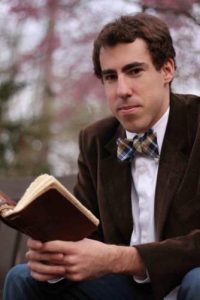Bradley Erickson completed the Graduate Certificate in Digital Humanities in Spring 2018. Current DIL student staff member Henry McKeand checked in with him a year later.

What was the subject of your Certificate research? Did your work in the program differ from what you had done before?
For my certificate project, I created 3D models of a series of cuneiform tablets housed in the special collection of Wilson Library. Because these tablets are delicate and housed in special collections, it can be difficult for other scholars or the public to access them. The end product was a display of the series of 3D models online (they can be viewed here: https://skfb.ly/6wwvF) as well as a series of 3D prints of the tablets.
To make the models, I used the process of Structure-from-Motion and photogrammetry to complete the models. These processes involves taking and using 2D photographs to generate a 3D object. I have been practicing photogrammetry since learning about it, and I have used a similar method in creating 3D models for my dissertation, which explores the ancient Jewish use of astronomy in the architecture of the ancient synagogue.
While completing the digital humanities certificate, I was fortunate to take a range of classes that let me explore creating 3D models, making maps, and using a number of different programming languages to complete tasks. Taking courses for the completion of the certificate has made it possible for me to engage with research that I never knew was possible before coming to UNC.
Describe your experience in the program. What were the challenges and rewards?
The series of courses that I took while completing the digital humanities certificate taught me new, critical ways to approach large projects. For example, before beginning a digital project a number decisions must be made about how the project will be presented at conferences, to the general public, and how the digital components will be preserved. Thinking about the ultimate end of a digital project forced me to structure the project’s work in a way to address those end goals. For example, one project included the fabrication of ancient glass oil lamps that would have hung in an ancient monumental building. I was interested in measuring the light output of such a lamp to envision how many light sources would be required. To complete the project I created a polycandelon (i.e. an ancient chandelier) and then built and 3D printed a series of oil lamps. I met with a glass blower who turned the 3D prints into actual pieces of glass. A colleague and I then filled the oil lamps with olive oil, wove flax wicks, and lit the lamps. We measured the light output using a luxmeter, which I then incorporated into 3D models of ancient synagogue buildings. This project is nearly complete and will be available for anyone to access the process and data. Such a large project took a lot of planning, and at the same time, it also took flexibility.
What was your biggest takeaway from the program? In what ways, if any, has receiving the Certificate benefited you?
The biggest take away from the program has been the spirit of collaboration between so many different fields. Digital humanities is not a solitary field, but requires everyone to bring skills to the table for mutual benefit. New jobs have opened for me both on and off campus that I would not have been able to do before completing the digital humanities certificate. I appreciate the professors and certificate directors who have opened these new career doors for me.



